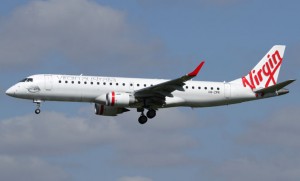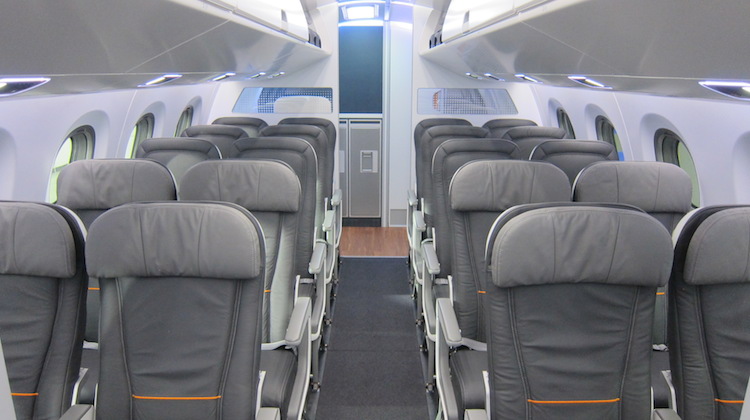
Embraer is confident its regional jet lineup will find new homes in Australia when older aircraft need replacing and operators realise the economic benefits of a 100-135 seat aircraft even as Virgin Australia moves to eliminate its E190s.
The Brazillian aircraft manufacturer recently appointed a new regional sales manager for Australia and New Zealand and will be present at the upcoming Australian International Airshow at Avalon talking up its current model E-jets and upgraded E2 lineup – which currently has three aircraft in flight test mode – as well as Embraer business jets and military offerings.
While Embraer is losing a major airline customer in the region in Virgin, Embraer Commercial Aviation vice president for Asia Pacific Mark Dunnachie says the withdrawn E190s have had no trouble returning to the skies with other operators.
“We would actually point out the positive that on a global basis the fluidity of the asset has been reaffirmed,” Dunnachie told Australian Aviation in an interview on the phone from Singapore ahead of the Avalon Airshow.
“Those aircraft are finding new homes, allowing Embraer to seed new customers. That’s a very important factor for us.
“We exit on a high, we exit on a good relationship and we will try and fight to get back in with E2s.”
Dunnachie acknowledged the Virgin decision to withdraw its 18 E190s, which are configured with six business and 92 economy seats, was disappointing.

However, the Embraer executive noted the move reflected Virgin’s current financial situation – the airline was attempting to pay down debt and cut costs in a bid to return to profitability – rather than any concerns about the aircraft itself.
“We all recognise that Virgin have had a very difficult ride over the last few years. They are facing difficulties as we speak,” Dunnachie said.
“I don’t think it is in any way reflective of any negative aspect on the product. Passengers love it.”
Indeed, other Embraer operators in Australia have grown their fleets in recent times. In September 2016, Airnorth picked up its fifth E170 jet, while Jetgo recently took delivery of two ERJ-140LRs for its burgeoning regular public transport network.
While Australia represented almost the ideal place for older aircraft to keep flying well into their third and sometimes fourth decade given the hot, dry climate across vast areas of the continent, there will come a time when even the Fokker 70s, Fokker 100s, BAe 146s and Avro RJs will need to be replaced.
And Embraer is hoping its E-jets will prove to be the right solution for operators of those existing aircraft.
“Excluding the 717, there’s about 80-odd aircraft in our category in Australasia that would eventually qualify for replacement or upgrade to something else,” Dunnachie said.
“That’s something we’re really focused on. Even if 50 per cent have a rollover potential that’s 40-odd units and that’s without growth in other segments.”
And should fuel prices continue to creep higher off the historic lows seen in recent times then “it starts to get very compelling to look at replacing them sooner than people had initially planned”, Dunnachie said.
While Virgin deploys its E190s across its domestic RPT network, the airline also has 100-seat Fokker 100s that are currently used only in Western Australia for a mix of scheduled and charter flights.

Meanwhile, Qantas has been using its fleet of 20 Boeing 717s on more capital city services in recent times in an effort to better match capacity with demand.
The E190-E2 was one of three models in the E2 family of jets that can seat between 97 and 114 passengers, depending on configuration. The first E190-E2 was expected to be delivered to launch customer Widerøe in the first half of 2018.
The E2 improves on the current generation E-jets with new aerodynamically advanced, high-aspect ratio, distinctively shaped wings, improved systems and avionics, including fourth generation full fly-by-wire flight controls.
This was expected to result in double-digit reductions in fuel and maintenance costs compared with the current E-jet family. From an environmental perspective, the new aircraft also produced less emissions and less noise. The aircraft will also have a new interior with larger overhead bins and a new first class concept, among other interior improvements.
The other two E2 models were the E175-E2, which seats 80-90 passengers, and the E195-E2 (120-144 seats).


Currently, the three E190-E2s flying as part of the flight test program have accumulated about 550 flight hours, according to figures from Embraer. A fourth flight test aircraft was in final assembly and expected to make its first flight in the coming weeks.
“The message that we are reinforcing very strongly in the market is very much on schedule for delivery in the first half of 2018 on the first E190-E2,” Dunnachie said.
Meanwhile, the first E195-E2 was also in final assembly, with the wing joined to the fuselage. And the first metal was cut for the E175-E2 in June 2016.
The E2 family of aircraft has secured 275 firm orders as of the end of January. When options, letters of intent and purchase rights are included, the total order book is 690 aircraft, Embraer said on February 14.
“We are sitting with a very comfortable position,” Dunnachie said.
“The incumbency that we have on the E1 is something that we keep pushing in the market which I think will give us a clear momentum buildup on the E2.”

“If you just look at the numbers on the E1, we are already at 1,700 orders with 1,300 deliveries.”
Dunnachie said there were also opportunities elsewhere in Oceania, particularly for trans-Tasman flights operating out of secondary points where the market may not be able to support aircraft the size of a Boeing 737 or Airbus A320.
Further, the Embraer executive said the E195-E2, when configured in its high-density 146-seat layout, “almost matches the seat-mile costs of the MAX and the neo but offers 20-30 per cent lower trip costs”.
Meanwhile, Dunnachie said Embraer planned to expand its maintenance, repair and overhaul (MRO) footprint in the Asia Pacific, with further details to be announced in the coming months.
A video from Embraer’s YouTube channel of the E190-E2’s first flight in May 2016:











